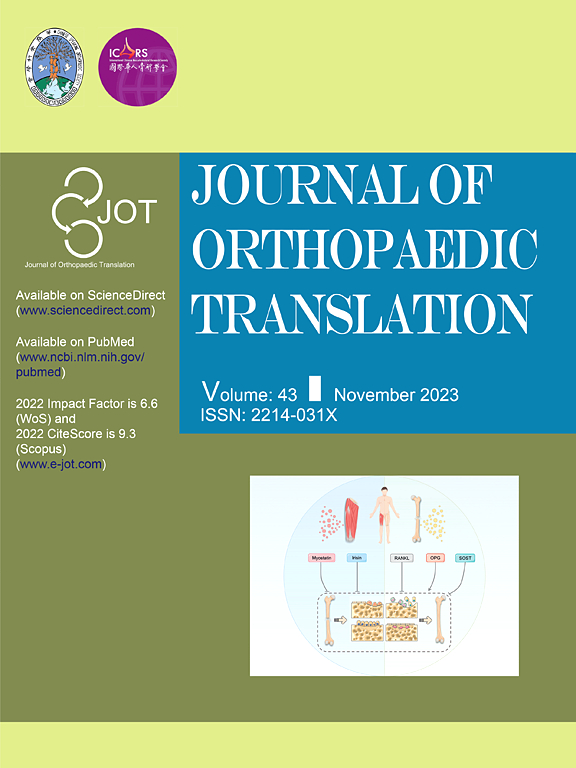靶向Piezo1通道缓解椎间盘退变
IF 5.9
1区 医学
Q1 ORTHOPEDICS
引用次数: 0
摘要
背景:全球有超过6亿人患有腰痛,主要原因是椎间盘退变。这项研究的重点是Piezo1,一个关键的机械敏感离子通道蛋白,在椎间盘退变的病理和潜在治疗中的作用。材料和方法为了研究圆盘特异性Piezo1缺失的影响,我们生成了AggrecanCreERT2;Piezo1fl/fl小鼠,并检查了腰椎不稳定(LSI)和衰老诱导的椎间盘退变。此外,在IL-1β刺激诱导椎间盘退变的离体模型中,使用GsMTx4(一种有效的Piezo1拮抗剂)评估了药理抑制Piezo1的效果。评估包括组织学检查、免疫荧光和免疫印迹分析,以彻底表征椎间盘的改变。结果在老年小鼠和人椎间盘退变晚期椎间盘髓核(NP)中均检测到Piezo1的高表达。在老年小鼠和接受LSI手术的小鼠中观察到,在表达聚集蛋白的椎间盘细胞中诱导缺失Piezo1表达可显著减少腰椎间盘退变,减少细胞外基质(ECM)降解,降低NP细胞凋亡。过度压缩负荷(CL)上调了NP细胞中Piezo1的表达,诱导了ECM的破坏,增加了细胞凋亡,而GsMTx4抑制Piezo1有效地减轻了这些病理变化。此外,在离体培养的小鼠椎间盘中,GsMTx4处理可显著减轻il -1β诱导的退行性损伤,恢复ECM合成代谢,减少细胞凋亡。结论Piezo1在椎间盘退变的发展中起着关键作用,并突出了其作为治疗靶点的潜力。抑制Piezo1可以为治疗或预防这种严重疾病提供一种新的策略。本研究强调了Piezo1在椎间盘退变发展中的作用,并强调了将Piezo1作为延缓或逆转这种疾病的治疗策略的潜力。本文章由计算机程序翻译,如有差异,请以英文原文为准。

Targeting Piezo1 channel to alleviate intervertebral disc degeneration
Background
Low back pain impacts over 600 million people worldwide, predominantly due to intervertebral disc degeneration. This study focuses on the role of Piezo1, a crucial mechanosensitive ion channel protein, in the pathology and potential treatment of disc degeneration.
Materials and methods
To investigate the effects of disc-specific Piezo1 deletion, we generated AggrecanCreERT2; Piezo1fl/fl mice and examined both lumbar spine instability (LSI)- and aging-induced disc degeneration. Additionally, the effect of pharmacological inhibition of Piezo1 was evaluated using GsMTx4, a potent Piezo1 antagonist, in an ex vivo model stimulated with IL-1β to induce disc degeneration. Assessments included histological examinations, immunofluorescence, and western blot analyses to thoroughly characterize the alterations in the intervertebral discs.
Results
Elevated expression of Piezo1 was detected in the nucleus pulposus (NP) of intervertebral discs with advanced disc degeneration in both aged mice and human patients. Inducible deletion of Piezo1 expression in aggrecan-expressing disc cells significantly reduced lumbar disc degeneration, decreased extracellular matrix (ECM) degradation, and lowered apoptosis in NP cells, observed in both aged mice and those undergoing LSI surgery. Excessive compression loading (CL) upregulated Piezo1 expression, induced ECM disruption, and increased apoptosis in NP cells, whereas inhibition of Piezo1 with GsMTx4 effectively mitigated these pathological changes. Furthermore, in ex vivo cultured mouse discs, GsMTx4 treatment significantly alleviated IL-1β-induced degenerative damages, restored ECM anabolism, and reduced apoptosis.
Conclusions
The findings suggest that Piezo1 plays a critical role in the development of disc degeneration and highlight its potential as a therapeutic target. Inhibiting Piezo1 could offer a novel strategy for treating or preventing this critical disease.
Translational potential of this article
This research highlights the involvement of Piezo1 in the development of intervertebral disc degeneration and emphasizes the potential for targeting Piezo1 as a therapeutic strategy to delay or reverse this condition.
求助全文
通过发布文献求助,成功后即可免费获取论文全文。
去求助
来源期刊

Journal of Orthopaedic Translation
Medicine-Orthopedics and Sports Medicine
CiteScore
11.80
自引率
13.60%
发文量
91
审稿时长
29 days
期刊介绍:
The Journal of Orthopaedic Translation (JOT) is the official peer-reviewed, open access journal of the Chinese Speaking Orthopaedic Society (CSOS) and the International Chinese Musculoskeletal Research Society (ICMRS). It is published quarterly, in January, April, July and October, by Elsevier.
 求助内容:
求助内容: 应助结果提醒方式:
应助结果提醒方式:


